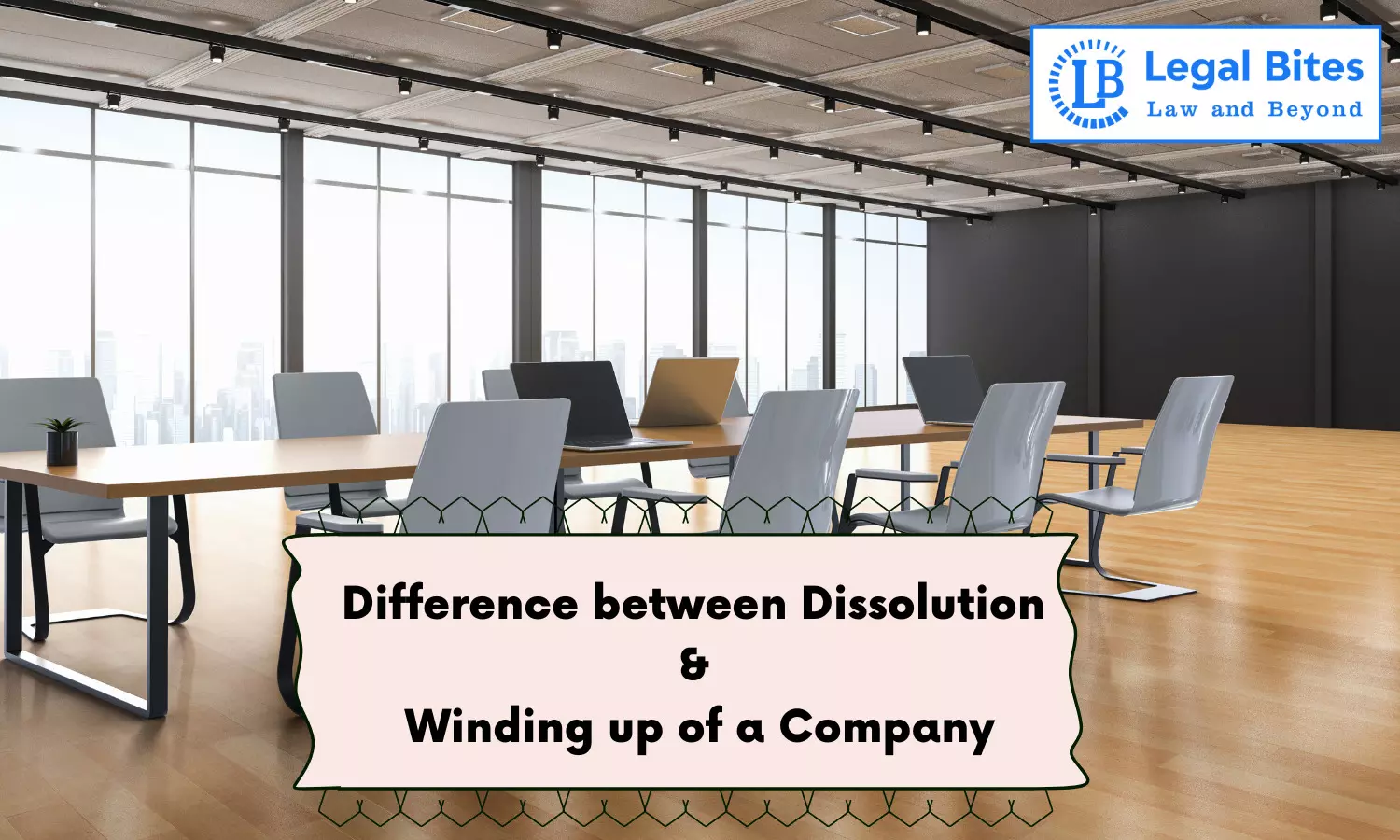Difference between Dissolution and Winding Up of a Company
The article 'Difference between Dissolution and Winding Up of a Company' provides a concise overview of the fundamental distinctions between "winding up" and "dissolution" as they relate to the closure of a company.

The article 'Difference between Dissolution and Winding up of a Company' provides a concise overview of the fundamental distinctions between "winding up" and "dissolution" as they relate to the closure of a company. The distinction between winding up and dissolution is very simple yet it is very crucial for any company to be well versed about such distinction for running a business successfully. A company is dissolved formally through a Company Winding Up and Dissolution of Company...
The article 'Difference between Dissolution and Winding up of a Company' provides a concise overview of the fundamental distinctions between "winding up" and "dissolution" as they relate to the closure of a company. The distinction between winding up and dissolution is very simple yet it is very crucial for any company to be well versed about such distinction for running a business successfully.
A company is dissolved formally through a Company Winding Up and Dissolution of Company process. This happens when all of the company's liabilities are paid off, and there is no plausible chance that it will be able to continue operating. Many things, including the company entering into liquidation or being voluntarily wound up by its shareholders, can be a reason for it. The process of a company dissolution is less formal and typically occurs when several businesses merge or when the shareholders decide to dissolve the business.
What is Winding Up?
The Insolvency and Bankruptcy Code, 2016 defines winding up as the formal liquidation of a company. It may be in the form of a voluntary winding up of a private limited company initiated by a corporate person or a compulsory winding up as prescribed by the company's creditors. It's a two-step procedure; the first step is the insolvency resolution process, and the second is the company's liquidation. While the firm is about to wind up, the corporate entity still remains in existence. However, after dissolution, the corporate entity loses its existence.
Differentiating Between the Process of Winding Up And Dissolution
When a company is winding up, a liquidator is appointed to auction off its assets, distribute the revenues to its creditors, and submit a dissolution request to the NCLT. One approach for carrying out a company's dissolution is by winding it up. When the winding-up process begins and continues, the legal entity of the corporation still remains in existence. When a company is undergoing a winding-up process, its operations may be permitted as long as it is necessary for the company to be winded up successfully.
The liquidator is appointed, declarations are received, reports are prepared, disclosures are made to the ROC, and a dissolution petition is filed with the NCLT as part of the winding-up procedure. On the other hand, Dissolution means to dissolve the company completely. The firm name cannot be used for any additional operations. The process/outcome of winding up and getting the name removed from the Register of Companies is dissolution. The company's existence as a legal entity ends with its dissolution. When it dissolves, the company is no longer a legal entity. Resolutions, declarations, and other paperwork must be submitted to the NCLT in order to get the dissolution order passed.
In India, the process for winding up a firm is entirely a judicial function, and the Tribunal adjudicates the case. The winding-up procedure is carried out and managed by a liquidator. The dissolution process begins after winding up. The registrar of companies records a company's dissolution. The liquidator has no role in this because it is solely administrative in nature. A step that must come after a company is going through winding up is dissolution.
Modes of Winding Up
A company might undergo the process of Winding up for a variety of reasons, but it's not as easy as just locking the doors to the company headquarters or avoiding work. It is even more time-consuming than incorporation itself winding up. As per Section 425 of the Companies Act, 2013, Winding Up can be further classified into two parts. They are:
1) Compulsory Winding Up which is initiated through the order of the Court
2) Voluntary Winding Up, which itself is of two kinds:
- Members’ Voluntary Winding Up
- Creditor’s Voluntary Winding Up
Compulsory Winding Up
In Compulsory Winding up, a company may be compelled by law to cease operations. A court order may be issued in this case after being decided in court. In these situations, the business would be required to name a liquidator. This liquidator would be in charge of overseeing the distribution of the money from the sale of the company's assets to its creditors. A lawsuit filed by the company's creditors frequently results in a court order. The creditors are often the first to realize and accept that a company has become insolvent, mostly because their bills will remain unpaid. In other situations, the bankruptcy proceeding comes to an end with the winding-up process. This can entail the company's creditors attempting to recover some of the money they are owed. Regardless of the situation, a company could not have enough assets to pay off all of its debt. This would lead the creditors to face an economic loss.
Voluntary Winding Up
If a Declaration of Solvency is made in accordance with the provisions of the Act, it will be referred to as a Members’ Voluntary Winding Up and if it is not done in such a manner, it becomes the Creditors’ Voluntary Winding Up. A majority of the directors present at the board meeting must make the declaration, which must be supported by an affidavit. They must certify that they have thoroughly investigated the company's operations and have come to the conclusion that it has no debts or that it will be able to pay all of its debts in full within a specific time frame, not to exceed three years from the commencement of winding up.
The declaration must be made within five weeks prior to the resolution's date in order to be valid, and it must be submitted to the Registrar for registration prior to that day. Additionally, it must include a summary of the company's assets and liabilities as of the declaration date as well as a copy of the auditors' report on the profit and loss account and balance sheet that have been completed up to that point.
Making the declarations without having sufficient grounds to believe that the company will be able to pay its debts within the allotted time attracts a penalty. It will be assumed that there were no reasonable grounds for making the declaration if the corporation fails to pay the debts in that time frame. The winding-up must then proceed as if it were a creditors' winding up, thus the liquidator should immediately summon a meeting of the creditors.
Conclusion
A company typically continues to operate until it either voluntarily dissolves itself or is forced by law to shut down permanently. Some individuals conflate the terms "winding up" and "dissolution" when referring to business closure. Winding up of the company means either with the self-belief of members or on receiving legal directions, the company ends its business affairs and terminates the company’s obligations with the other world agencies. On the other side, dissolution is a fast method to shut down a business that involves winding up of the company without going through all the regulatory obligations.
References
[1] Difference between Dissolution and Winding Up of a Company, Available Here
[2] Neelansh Gupta, Modes of Winding Up of a Company as per Companies Act, Available Here
[3] Will Kenton, Winding Up v. Bankruptcy: How it Works, Available Here
[4] Dhruv, Bharadwaj, Winding up of a Company, Available Here
[5] Difference Between Dissolution and Winding Up of a Company, Available Here
[6] Amir Arsiwala & Ishan J Ravindranath, Winding Up v. The Insolvency and Bankruptcy Code, 2016, Available Here
Important Links
Law Library: Notes and Study Material for LLB, LLM, Judiciary, and Entrance Exams

Snehil Sharma
Snehil Sharma is an advocate with an LL.M specializing in Business Law. He is a legal research aficionado and is actively indulged in legal content creation. His forte is researching on contemporary legal issues.
